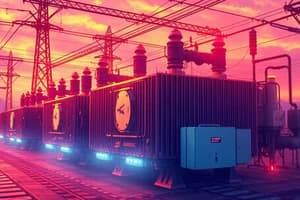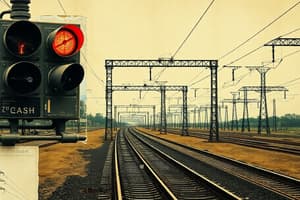Podcast
Questions and Answers
What does instruction time (I-time) refer to?
What does instruction time (I-time) refer to?
- The time taken for data retrieval from memory
- The time to perform the make-instruction and decode instruction steps (correct)
- The time required for data storage
- The time it takes to execute a program
Which of the following best describes pipelining in CPU operation?
Which of the following best describes pipelining in CPU operation?
- Performing multiple processing phases in a single machine cycle (correct)
- Randomly executing phases without a set order
- Storing data in multiple locations
- Executing instructions one at a time
Which of the following operating systems listed is not a mobile device operating system?
Which of the following operating systems listed is not a mobile device operating system?
- iOS
- Ubuntu OS
- Windows OS (correct)
- Android OS
What characteristic of computers allows them to handle many tasks simultaneously?
What characteristic of computers allows them to handle many tasks simultaneously?
What does the storage capacity of a computer refer to?
What does the storage capacity of a computer refer to?
How much data can a single high density video disk (HVD) hold compared to a standard data DVD?
How much data can a single high density video disk (HVD) hold compared to a standard data DVD?
Which of the following is a feature that makes computers reliable?
Which of the following is a feature that makes computers reliable?
Which classification of computers is designed to perform a specific range of tasks?
Which classification of computers is designed to perform a specific range of tasks?
What is the primary function of hardware in a computer system?
What is the primary function of hardware in a computer system?
Which of the following is NOT considered a component of computer hardware?
Which of the following is NOT considered a component of computer hardware?
What is the first step in installing memory (RAM)?
What is the first step in installing memory (RAM)?
Which component needs to have its power cable connected before it can operate fully?
Which component needs to have its power cable connected before it can operate fully?
What should students learn about computer maintenance according to the objectives?
What should students learn about computer maintenance according to the objectives?
Which is a limitation of computers as mentioned in the objectives?
Which is a limitation of computers as mentioned in the objectives?
What should be done after removing the expansion slot covers when installing a graphics card?
What should be done after removing the expansion slot covers when installing a graphics card?
What do students familiarize themselves with in this learning module?
What do students familiarize themselves with in this learning module?
How are storage drives fixed in place within a computer case?
How are storage drives fixed in place within a computer case?
What is an important consideration when installing RAM into the motherboard?
What is an important consideration when installing RAM into the motherboard?
What role do practical exercises play in this learning module?
What role do practical exercises play in this learning module?
What action should be taken for optical drive installation?
What action should be taken for optical drive installation?
How is the delivery of this learning material structured?
How is the delivery of this learning material structured?
What is a characteristic of microcomputers?
What is a characteristic of microcomputers?
What is one of the expected outcomes after completing the lesson?
What is one of the expected outcomes after completing the lesson?
Which type of computer is characterized by processing data at high speeds and serving multiple users?
Which type of computer is characterized by processing data at high speeds and serving multiple users?
Which of these components can be installed using a SATA cable?
Which of these components can be installed using a SATA cable?
Which step follows after installing the graphics card into the PCI expansion slot?
Which step follows after installing the graphics card into the PCI expansion slot?
What is the main defining feature of analog computers?
What is the main defining feature of analog computers?
What differentiates a supercomputer from other types of computers?
What differentiates a supercomputer from other types of computers?
Which statement best describes digital computers?
Which statement best describes digital computers?
What is a key feature of hybrid computers?
What is a key feature of hybrid computers?
What defines a minicomputer's performance compared to a microcomputer?
What defines a minicomputer's performance compared to a microcomputer?
Which of the following types of computers is the largest and most powerful?
Which of the following types of computers is the largest and most powerful?
What is the primary function of a PSU in a computer system?
What is the primary function of a PSU in a computer system?
Which of the following is an example of an input device?
Which of the following is an example of an input device?
What distinguishes volatile memory from non-volatile memory?
What distinguishes volatile memory from non-volatile memory?
What should be done to avoid damage from static electricity when assembling a PC?
What should be done to avoid damage from static electricity when assembling a PC?
Which of the following devices performs the function of producing results from data processing?
Which of the following devices performs the function of producing results from data processing?
What is the purpose of tools like screwdrivers and anti-static mats during PC assembly?
What is the purpose of tools like screwdrivers and anti-static mats during PC assembly?
Which of the following statements is true about storage devices?
Which of the following statements is true about storage devices?
What is a crucial step before beginning the assembly of a computer?
What is a crucial step before beginning the assembly of a computer?
Study Notes
Power Supply Installation
- Connect the 8-pin PSU connector to the CPU power connector securely.
Memory (RAM) Installation
- Open the clips on both ends of the RAM slot.
- Align the RAM stick's notch with the mounting slot.
- Firmly press the RAM into the slot until clips latch closed.
- Repeat the process for additional RAM sticks.
Graphics Card Installation
- Remove expansion slot covers from the rear of the case.
- Insert the graphics card into a PCI slot on the motherboard, pressing down firmly.
- Secure the card using screws.
- Connect power from the PSU to the graphics card if required.
Storage Drive Installation
- Mount storage drives into designated case bays using screws to secure them.
- Connect the drive to the motherboard using a SATA cable.
- Plug in the power cable from the PSU to the storage device.
- Follow the same procedure for any additional storage drives.
Optical Drive Installation
- Remove necessary front panels from the computer case for the optical drive.
Key Computer Components Overview
- Hardware: Physical components used for input, processing, and output activities.
- Instruction Time (I-time): Duration required for instruction making and decoding.
- Execution Time (E-time): Duration to process and store results in memory.
- Data Storage: Data storage is now compact; a single DVD holds 4.8 GB, compared to 90 million punch cards to match the same capacity.
Computer Characteristics
- Speed: Capable of calculations at remarkable speeds, simulating millions of mathematicians.
- Reliability: High reliability, errors usually result from human input, not machine failure.
- Multitasking: Ability to perform multiple tasks simultaneously.
- Diligence: Computers do not experience fatigue or boredom.
- Accuracy: Rarely make mistakes; processing is precise.
- Storage Capacity: Can manage vast amounts of data.
Types of Computers
- Microcomputers: Small, versatile, and commonly used by individuals.
- Mini Computers: More powerful than microcomputers, designed for multiple users.
- Mainframe Computers: High-speed processing for managing large data for multiple users.
- Super Computers: The most powerful, capable of processing trillions of instructions per second.
Computer Classifications by Functionality
- Analog Computers: Use continuous physical phenomena to solve problems, measuring and interpreting data.
- Digital Computers: Perform calculations and mathematical operations using binary digits (0s and 1s).
- Hybrid Computers: Handle both digital and analog inputs and outputs.
Power Supply Unit (PSU)
- Converts AC from the power outlet to usable DC for the computer components.
Peripheral Devices
- Input Devices: Include keyboard, mouse, and microphone, used to enter data and instructions.
- Output Devices: Include monitors, printers, and speakers, used to present processed data.
- Storage Devices: Non-volatile storage like HDD retains data without power, unlike volatile RAM.
PC Assembly Guidelines
- Use proper tools: screwdrivers, anti-static wrist strap, and a flat surface for assembly.
- Ensure a clean, well-lit workspace to prevent damage to components.
- Discharge static electricity by touching a metal surface before working on parts.
- Always disconnect power and allow components to discharge before handling.
- Avoid assembling individual parts like PSU or monitor in isolation, and handle sharp edges with care.
Studying That Suits You
Use AI to generate personalized quizzes and flashcards to suit your learning preferences.
Related Documents
Description
This quiz covers the essential steps for installing a power supply unit (PSU) and RAM in a computer system. It includes detailed instructions for connecting the 8-pin connector and properly mounting the RAM. Test your knowledge on these fundamental computing concepts.




